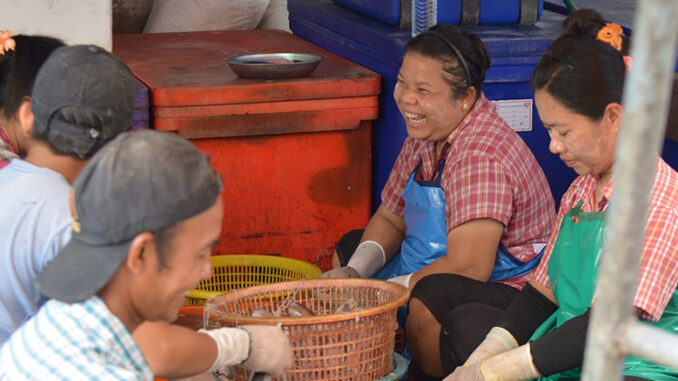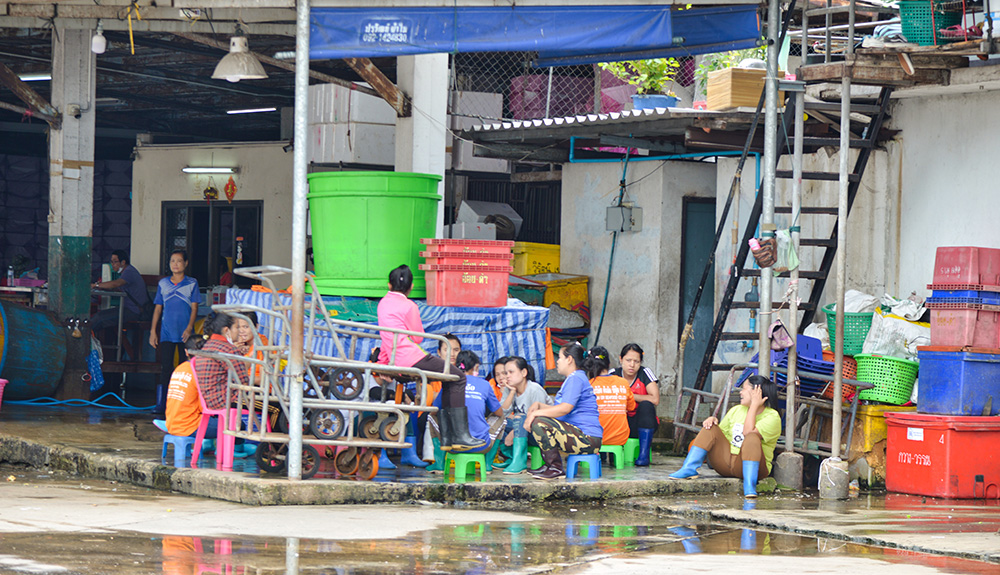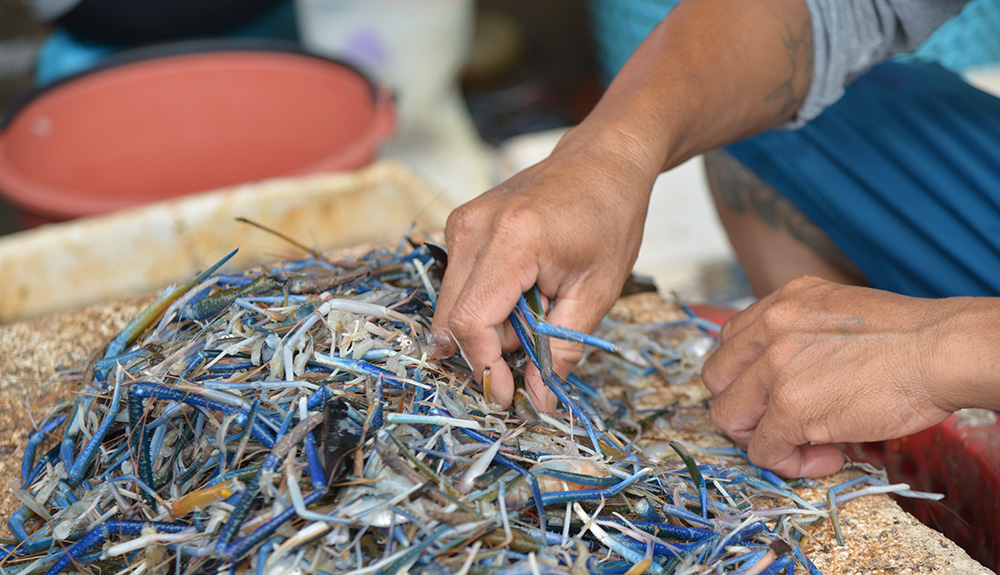
More than twenty years have passed since workers from Myanmar, Laos, and Cambodia began migrating to Thailand under different bilateral agreements, and presently, they make up one of the largest groups of workers in the country. Their arrival in Thai territory has been undoubtedly crucial to driving the country’s economy forward. However, because Thai and Myanmar (including Mon, Karenni and Tavoyan) are not similar in terms of language family, workers from Myanmar are less likely to understand Thai than those from Laos or even Cambodia. Workers of Myanmar migrant groups always find it harder to talk to Thai officials at government service centers, particularly if they have not learned the host country’s language beforehand.
Health care and other public services are basically two areas where migrant workers could greatly benefit from translation or interpreting services. Yet, academic proposals for upgrading methods of migrant assistance with translation and interpreting are often not put into practice. Although some attempts have been made to encourage language-related projects, the results of implementation have always been unfavorably inadequate or encounter problems in their long-term implementation—a lack of staff, training resources, or guidelines to support them (Kosiyaporn et al., 2020).
The dynamism of this problem, nevertheless, suddenly appeared toward the end of the year 2020, when it was reported that settlements of migrant workers in Samut Sakhon, a tiny seaside region in Thailand, became the epicenter for the second wave of virus infections in the country. As the situation of reported cases in these communities gradually worsened, the task of healthcare authorities grew ever more demanding and arduous. The timely detection of the cluster of infected migrants was not fully achieved, making the virus further spread to nearby residents of the host country’s citizens (Khemanitthathai, 2021). For Myanmar migrants, language barriers made it even harder for those who needed to learn more about healthcare to understand COVID-19 situations and preventive measures. Furthermore, the nature of the ineffectual responses at the national level, as Suwanwattana (2023) argues, may partially stem from the then premiership’s dominant discourse—prophylactic nationalism that has been virtually meant to maintain the authorities in power and the myth of Thai unity. In contrast, many civil society organizations appeared to take the lead in implementing preventive measures with some language assistance. Raks Thai Foundation, for example, distributed masks and alcohol gel along with teaching the migrant communities how to follow daily self-care guidelines and how to help stop the spread of the COVID-19 virus in their own areas. All these were aimed especially at those who lost their jobs without warning, workers with little children, and workers with bedridden relatives (Raks Thai Foundation, 2021).

When looking at these situations from different perspectives, it becomes clear that a lack of language support for workers from Myanmar, notably a lack of translation and interpreting services, is one of the contributing factors. Previous research in healthcare communication has consistently highlighted how important translated services are for getting important information to all social groups that speak different languages. This includes policy recommendations, healthcare perceptions, medical linguistics, and bilingual consultations (e.g., Dysart-Gale, 2007; Federici & Declercq, 2020). Translation and interpreting for migrants can also help with health literacy—to find, process, and use information effectively to improve and maintain personal health. With this idea in mind, translators and interpreters who have an understanding of the interplay between speech, text, and sociopolitical context can help effectively relay life-necessary messages among traditionally underrepresented languages (Montalt-Resurreccio, 2021).
In a society where justice for migrants and linguistic diversity are present, it is possible for everyone to live in desirable harmony. By adopting this perspective, scholars of translation and interpreting can choose to promote extensive activist research that campaigns for closing power disparities in practice and discourse (Marais, 2013). For example, Taibi (2014) advocates for community translation/interpreting initiatives in underprivileged communities and the conditions for the fair availability of legal, educational, and social services. By supporting the rights of marginalized and more equitable societies, Baker (2020) posits that translators can play a potential role in altering many enduringly discriminatory societies of the twenty-first century. In fact, Van Parjis’s (2011) concept of linguistic justice can aptly justify providing language assistance to migrant workers—minority groups should receive more equitable resource allocation because denying this favour to marginalized people would have a disproportionate and negative impact on others, particularly the host country’s population in this case.
I have argued elsewhere (Phanthaphoommee, 2022) that more equitable resources in this context relate to information accessibility through translation and interpreting. Unfortunately, again, the Thai state’s management of the plight of migrant workers amid the coronavirus crisis underlines the failed attempt to deliver the potential services that should come with language rights. In a study on translators’ networks in Thailand during the COVID-19 outbreak (Techawonstien & Phanthaphoommee, 2022), my colleague and I similarly observed that the government’s translation/interpreting projects were lackadaisical in addressing the linguistic needs of migrants, who have made a major contribution to the country’s economy. This indicates that Thai linguistic nationalism is still powerful despite the state’s establishment of an almost-inclusive national language policy.

In my essay about the paradox of living in a monolingual society like Thailand (Phanthaphoommee, 2022), I adopted Blommaert’s (2009) ideas of the ‘national order of things’ to explain this—the fact that marginalized people seldom have enough access to language support symbolizes the uniform that a country uses to control how the public sees its national language and create unchangeable social orders. It can also be understood as the authorities’ constructed version of multilingualism, which contrasts with the true language diversity within migrants’ and nearby communities, as these multilingual locations are always viewed by the ‘center’ as monolingual. This is coupled with the fact that the existing Thai interpreter/translator network is not fully developed, despite its potential to help the government improve health communication with underprivileged groups (Techawonstien & Phanthaphoommee, 2022).
Related to this is a critical essay by novelist Arundhati Roy, for it offers consolation to the marginalized in Indian society during the pandemic. She wrote: “We can choose to walk through it [the pandemic], dragging the carcasses of our prejudice and hatred, our avarice, our data banks and dead ideas, our dead rivers and smoky skies behind us. Or we can walk through lightly, with little luggage, ready to imagine another world.” This statement implies that optimism toward change can be inspired by a small social network’s aspiration—such as individual translators/interpreters with a social justice mindset (e.g., Baker, 2020)—to convert inequitable conditions into more inclusive practices. However, considering this with an implication for migrant workers in Thailand, a question remains: What ‘little luggage’ they can ‘walk’ with day-to-day when the fundamental right to language is still obstructed by policies that tend to devalue and downplay languages other than Thai as an irrelevance to the nation’s pride and development?
Narongdej Phanthaphoommee
Research Institute for Languages and Cultures of Asia, Mahidol University
Kyoto Review of Southeast Asia: Issue 39, Trendsetters, February 2025
All photos: Piyawan Kohkaew
References
Baker, M. (2020). Translation and solidarity in the century with no future: Prefiguration vs. aspirational translation. Palgrave Communications, 6, 1-10.
Blommaert, J. (2009). Language, asylum, and the national order. Current Anthropology, 50(4), 415-441.
Federici, F. M. & Declercq, C., (Eds.). (2019). Intercultural crisis communication: Translation, interpreting and languages in local crises. Bloomsbury Publishing.
Dysart-Gale, D. (2007). Clinicians and medical interpreters: negotiating culturally appropriate care for patients with limited English ability. Family & Community Health, 30(3), 237-246.
Khemanitthathai, S. (2021). Situation on migrant workers and border crossing during the Covid-19 pandemic. Migrant Working Group.
Kosiyaporn, H., Julchoo, S., Phaiyarom, M., Sinam, P., Kunpeuk, W., Pudpong, N., … & Suphanchaimat, R. (2020). Strengthening the migrant-friendliness of Thai health services through interpretation and cultural mediation: a system analysis. Global Health Research and Policy, 5(1), 1-13.
Marais, K. (2013). Exploring a conceptual space for studying translation and development. Southern African Linguistics and Applied Language Studies, 31(3), 403–414.
Montalt-Resurrecio, V. (2021). Medical translation in crisis situations. In M. Federici & C. Declercq (Eds.), Intercultural crisis communication: Translation, interpreting and language in local crises (pp. 105-125). Bloomsbury.
Phanthaphoommee, N. (2022). Public service interpreting/translation for migrant workers during the COVID-19 pandemic in Thailand: Multilingual promotional efforts in a perceived monolingual space. In K. Sasiwongsaroj, K. Husa, & H. Wohlschlägl (Eds.), Migration, ageing, aged care and the COVID-19 pandemic in Asia: Case studies from Thailand and Japan (pp. 271-301). Department of Geography and Regional Research, University of Vienna.
Raks Thai Foundation. (2021). Cross-border migrant workers and Covid-19. https://www.raksthai.org/en/projects-content.php?category=5&sort=&id=37
Roy, A. (2020). Arundhati Roy: ‘The pandemic is a portal’. Financial Times, April 4. https://www.ft.com/content/10d8f5e8-74eb-11ea-95fe-fcd274e920ca
Suwanwattana, W. (2023). Prophylactic nationalism: COVID-19 in Thai public health discourse” In Blumczynski, P., & Wilson, S. (Eds.), The languages of COVID-19: Translational and multilingual perspectives on global healthcare (pp. 63-78). Routledge.
Taibi, M. (2014). Community interpreting and translation in the Arab world: Status quo and strategies for change. Babel, 60(1), 52-69.
Techawongstien, K., & Phanthaphoommee, N. (2022). Unintentional containment of the contaminated: The role of translation and interpreting during the COVID-19 crisis in Thailand. Journal of Internationalization and Localization, 9(2), 181–207.
van Parjis, P. (2011). Linguistic justice for Europe and for the world. Oxford University Press.
